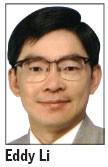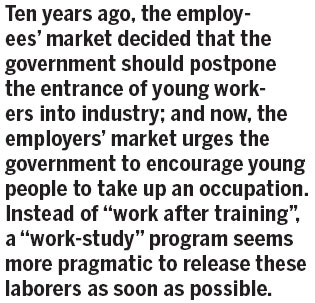Youth to solve labor shortage issue
Updated: 2013-06-07 06:36
By Eddy Li(HK Edition)
|
|||||||||
The latest statistics show Hong Kong's unemployment rate is 3.5 percent and the underemployment rate is only 1.6 percent, which almost reach the theoretical status of full employment. Ten years ago, when SARS swept Hong Kong and put the city's economy in its downturn, the unemployment rate in 2003 was as high as 8.7 percent, overstaffing all industries. But now, the situation is just the contrary, in many industries in the city, including catering, retail, hotel, and manufacturing industries, labor shortage is becoming a more and more severe problem, triggering public concern.

It has become one of the most urgent tasks for the government to solve the labor shortage issue, for the majority - the small- and medium-sized enterprises - is now already suffering from the pressure of high salaries, rental and material costs, and the labor shortage will be fatal to them. The most effective measure is to add fresh blood into the labor market, and the key source lies in the tens of thousands of secondary school graduates every year.
Back when Hong Kong was suffering from the consequences of SARS, only 20 percent of the young secondary school graduates had the chance to enter universities. The remainder (more than 70 percent) had to join the ranks of the unemployed, forcing the government to take different measures to settle them down. This was exactly the time when the government decided to open the Youth Pre-employment Training Programme (YPTP), Project Yi Jin, a continuing education program for school leavers and other programs, with the purpose of providing pre-employment training and professional development opportunities, enabling the young to be well prepared for integrating into society instead of being social loafers, while on the other hand postponing their entrance to work, to avoid pushing up the unemployment rate even further and reducing social turbulence to the minimal level.
The policies were especially pertinent to that specific period. As for now, however, the situation has totally changed - what Hong Kong faces at the moment is a labor shortage in many industries rather than a high unemployment rate. Therefore, the Hong Kong SAR government should adapt the related policies to suit the current environment. Ten years ago, the employees' market decided that the government should postpone the entrance of young workers into industry; and now, the employers' market urges the government to encourage young people to take up an occupation. Instead of "work after training", a "work-study" program seems more pragmatic to release these laborers as soon as possible.

In the 2013-14 Budget delivered by the financial secretary this year, it stated that a HK$15 billion fund will be given to the Employees Retraining Board (ERB). With the funding, the ERB can perform a more important role in on-the-job training: other than the provision of business knowledge and technical training, the board should also set up courses that are beneficial for the young people to obtain higher education, for example, or set up bachelor's degree programs. In this case, the young employees will have their knowledge and techniques enhanced and, more importantly, have the opportunity to get degrees through hard work. By doing this, they will be able to get greater social recognition, be more eligible for promotion, and utilize their talent to the best of their ability in a higher position. I believe this will definitely be good news for those who never got the chance to enter universities.
If the suggestion is adopted and the related policy is successfully executed, it not only solves the severe shortage in the labor market in a short time by adding fresh blood, but also provides the young employees with the opportunity to seek higher education in life and a higher position in work, benefiting the whole society by combining the two aspects.
The author is vice-president of the Chinese Manufacturers' Association of Hong Kong.
(HK Edition 06/07/2013 page9)